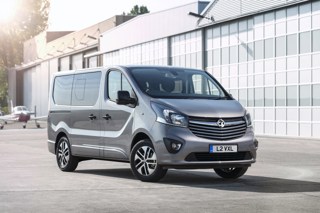Review
Vivaro is an accomplished performer, but higher running costs put it at a disadvantage for fleets, concludes Matt de Prez.
Vauxhall has been a strong performer in the mid-size panel van segment for more than a decade, but the success of the Vivaro has been slowly slipping since the new model was introduced in 2015.
Sales dropped by 4,000 units last year, and in the first quarter of 2018 the Ford Transit Custom outsold the Vivaro by 10,000 units.
The problem, at least from a fleet perspective, is that the Vivaro’s costs just aren’t competitive.
PSA Group products, the Citroën Dispatch and Peugeot Partner, offer a much more attractive package for fleets, with running costs of around 5p per mile less.
Perhaps that is why Vauxhall – now owned by PSA Group – has announced that a new Vivaro, based on the PSA platform, will be launched next year.
It’s not until you drive the current Vivaro that you remember why it has been so successful in the past. The cabin is well laid out and comfortable. The driving position is great and the van is easy to manoeuvre.
Our only criticism is that the storage bins – although plentiful – are all very large. So, if you want to have smaller items such as keys to hand they tend to end up in a different part of the van by the time you arrive.
We tested the smallest Vivaro (L1 H1) in the higher of two trims (Sportive). Equipped with a 145PS 1.6-litre Bi Turbo diesel engine, the Vivaro is both frugal and powerful.
The engine is quiet and smooth, which is excellent for longer distances. Coupled with fuel consumption of more than 42mpg (official figure 46mpg), the package is impressive.
Pricing for the Vivaro is where things start to go wrong. Our test model costs more than £25,000 and base models have a list price from £22,000.
When we compared specifications and running costs for an entry-level Vivaro against its main competitors, the Vivaro came out bottom.
Although equipment levels are high, the Peugeot Expert is £2,000 cheaper. Other rivals such as the Transit Custom and Trafic cost roughly the same as the Vivaro, giving it no competitive edge.
The Vivaro’s payload of 1,060kg (5.2 cubic metres) is also trumped by the Peugeot’s 1,118kg (5.3 cubic metres). And it’s the same story with CO2 emissions (144g/km vs 160g/km).
Running costs of 40.4p per mile are marginally worse than those of the Trafic (39.6p), but can’t compete with the Transit Custom (37.5p) and Expert (35.5p).
Higher-spec versions of the Vivaro fare slightly better, but these are more likely to be bought by private buyers or SMEs than larger fleets.
Sharing a platform with the Renault Trafic, the Vivaro has one key differentiator – it is built in Britain.
While this may have added appeal for some fleets or businesses, we believe that for most it will come down to costs.
Fleets would have to negotiate a significant discount on the list price for the Vivaro to tip the scales in its favour.
Verdict
The Vauxhall Vivaro is an excellent product that ticks almost all the boxes. Unfortunately, its rivals just offer a more attractive package for fleets when it comes to running costs (based on list price).
Model tested: Sportive 1.6BI










 Diesel
Diesel














